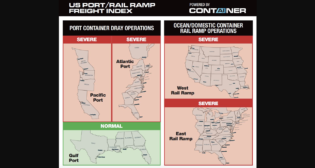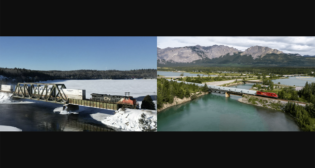
U.S. regulators reviewing crude-by-rail
Written by Douglas John BowenThe review, already well under way, will be checking on rail manifests to make sure they accurately reflect cargo volume and other specifics, and to make sure trains are adequately staffed, PHMSA Administrator Cynthia Quarterman told reporters during a break at an Aug. 22 emergency meeting of the Railroad Safety Advisory Committee (RSAC) in Washington.
“We need to make sure that what is in those tankers is what they say it is,” Quarterman said. “FRA and PHMSA together are going out with our inspection teams looking at crude in these cars and measuring them and ensuring that the quality of the crude that is being carried is what the shipping papers say it is.”
The review, officially called “Operation Classification” but tagged the “Bakken Blitz,” takes into account serious concerns generated by the explosion and derailment in Lac-Megantic, Quebec, last month of a Montreal, Maine & Atlantic CBR train that killed at least 47 and caused extensive damage to the municipality. The review primarily involves shipments from the Bakken; its activities include unannounced spot inspections, data collection, and sampling, as well as verifying compliance with federal safety regulations. The activities are taking place at strategic terminal and transloading locations that service crude oil.
Planning for the inspections started in March—well before Lac-Mégantic—following FRA audits and PHMSA field observations that found inconsistencies with crude oil classification, the agencies said.
The exact contents of the tank cars carrying crude is a major aspect of the Lac-Mégantic investigation. Bakken crudes tend to be lighter and thus more volatile than other grades. “The explosion in Lac-Mégantic was very unusual for crude,” FRA Administrator Joseph Szabo said. “Generally speaking, most grades of crude would not be that volatile. Our big concern at the moment is [verifying that] what is in a tank car is what people say is in a tank car, because there are certain requirements they have to meet if the flash point is different from what the regulations say. For example, they should have a safety and security plan if they are shipping something that is extremely volatile, which means they should be taking into account already some of the issues we’re talking about today, including securement.”
Early this month the FRA issued an Emergency Order “to help prevent trains operating on main line tracks or sidings from moving unintentionally,” specifically, those hauling certain types of hazardous materials, such as crude oil and ethanol.
In a July 29 letter to the American Petroleum Institute, FRA said its safety concerns stem from three considerations:
1. Crude oil transported by rail is often derived from different sources and is then blended, so it is critical that shippers determine the proper classification of the crude oil per the HMR (Hazardous Materials Regulations; Title 49 CFR Parts 171-180). In addition, we request that FRA audits of crude oil loading facilities indicate that the classification of crude oil being transported by rail is based solely on Material Safety Data Sheet (MSDS) data, which provides a material classification and a range of material properties. This MSDS information is typically provided by the consignee to the shipper, and the shipper is unaware of validation of the values of the crude oil properties.
Further, FRA’s audits indicate that MSDS information is not gleaned from any recently conducted tests or from testing for the many different sources (wells) of the crude oil. For example, a shipper provided information to FRA showing that crude oil being transported by rail had a flash point of 68 degrees F, or a Packing Group I hazardous material. However, the crude oil had been improperly classified as a Packing Group III material and was being transported in AAR class tank cars that were not equipped with the required design enhancements. This constituted a misuse of the crude oil HMR packaging exceptions and subsequent violations of the HMR.
The HMR contain exceptions that allow for the use of non-DOT-specification tank cars for the transportation of crude oil in certain circumstances. Title 49 CFR 173.150(f)(l) states, “A flammable liquid with a flash point at or above 100 degrees F that does not meet the definition of any other hazard class may be reclassified as a combustible liquid.” Further, 49 CFR 173.150(f)(3) allows materials that are classified as combustible liquids to be transported in non-DOT-specification bulk packagings. As such, AAR 211 class cars are permitted to be used to transport crude oil that has been classified as a Packing Group III material with a relatively high flash point. These cars are not built and/or maintained to the standard of a DOT-specification tank car. This distinction has safety implications if the crude oil being transported has been improperly classified and actually has a lower flash point and is a Packing Group I flammable liquid hazardous material. If improperly classified, the crude oil might then be shipped in a lesser standard tank car, as occurred in the above example.
Unfortunately, the AAR standard transportation commodity code data does not distinguish between the different packing groups within the hazard class. Without further information in that regard, and in relation to the accuracy of crude oil classifications being made, FRA can only speculate as to the number of potential crude oil shipments that are being made in AAR class tank cars in violation of the HMR. Recently, the AAR Tank Car Committee introduced new requirements for tank cars constructed for ethanol and crude oil (Packing Groups I and II) service. The new requirements are intended to improve the crashworthiness of the tank cars and include a thicker shell, head protection, top fittings protection, and relief valves with a greater flow capacity. Clearly, any improper classification of crude oil and subsequent shipment in an unauthorized tank car contravenes these industry efforts to improve the safety of transporting hazardous materials, and it also contravenes the requirements of the HMR.
2. Title 49 CFR 173.24b(a) sets the minimum tank car outage for crude oil at 1% at a reference temperature based on the existence of tank car insulation. A crude oil shipper must know the specific gravity of the hazardous material at the reference temperature as well as the temperature and specific gravity of the material at that temperature when loaded. This information is then used to calculate the total quantity that can be safely loaded into the car to comply with the HMR’s 1% outage requirement. Because it is likely that the temperature of the hazardous material loaded into the car is lower than the reference temperature, the outage after the car is loaded will likely be greater than 1%. If the outage is not properly calculated because the material’s specific gravity is unknown (or is provided only as a range), the tank car could be loaded such that if the temperature increases during transportation, the tank will become shell-full and the material will leak from the valve fittings or manway.
Since 2004, approximately 10% of the one-time movement approval (OTMA) requests that FRA has received have been submitted to move overloaded tank cars. Of these requests, 33% were tank cars containing flammable liquids. FRA notes that tank cars overloaded by weight are typically identified when the tank cars go over a weigh-in-motion scale at a railroad’s classification yard. As indicated above, crude oil is typically moved in unit trains, and the cars in a unit train do not typically pass over weigh-in-motion scales in classification yards. Therefore it is unlikely that FRA would receive many OTMA requests for overloaded tank cars containing crude oil.
Moreover, crude oil accounted for the most non-accident releases (NARs) by commodity in 2012, nearly doubling the next highest commodity (alcohols not otherwise specified, which accounts for a comparable annual volume transported by rail). FRA’s data indicates that 98% of the NARs involved loaded tank cars. Also, less than 2% of the NARs occurred at the bottom outlet valve. Product releases through the top valves and fittings of tank cars when the hazardous material expands during transportation suggest that loading facilities may not know the specific gravity of the hazardous materials loaded into railroad tank cars, resulting in a lack of sufficient outage.
3. FRA’s review of the OTMA data also indicates an increasing number of incidents involving damage to tank cars in crude oil service in the form of severe corrosion of the internal surface of the tank, manway covers, and valves and fittings. A possible cause is contamination of the crude oil by materials used in the hydraulic fracturing (fracking) process that are corrosive to the tank car tank and service equipment. Therefore, when crude oil is loaded into tank cars, it is critical that that the existence and concentration of specific elements or compounds be identified, along with the corrosivity of the materials to the tank car tanks and service equipment. Proper identification of these elements will enable a shipper to ensure the reliability of the tank car. Proper identification also enables a shipper to determine if there is a need for an interior coating or lining, alternative materials of construction for valves and fittings, and performance requirements for fluid sealing elements, such as gaskets and o-rings.
As a result of these concerns, FRA is investigating whether crude oil is being properly classified and, subsequently, whether the proper tank car packagings are being used for transportation. As part of this investigation, FRA will be requesting analytical data supporting the current classification of a shipper’s crude oil, as well as information related to shipper crude oil loading practices. If analytical data regarding the current classification of crude oil is not available, FRA, in partnership with PHMSA, said it may use PHMSA’s Hazardous Materials Testing Program. Under this program, a sample of a shipper’s hazardous material is sent to a certified laboratory for testing, and the results of the laboratory testing are then shared with the shipper. FRA may also consider exercising its authority under 49 CFR 109.9 to determine whether crude oil is being properly classified and transported in HMR-authorized packaging. If an investigation reveals that crude oil is not being properly classified per the HMR, FRA said it may use its enforcement tools to address noncompliance. Some of these enforcement tools include the issuance of compliance orders, emergency orders, and civil penalties.
The RSAC has been asked to examine current rules in light of Lac-Mégantic. It will look at issues such as whether trains carrying hazmat should be allowed to operate with one-person crews, as was the case with the MM&A train. Other issues include how to properly secure trains that are left unattended, and whether trains carrying certain hazmat loads should be left unattended. The RSAC, which will split into working groups, has been asked to report back to the FRA with recommendations in April 2014.
Railway Age Managing Editor Douglas John Bowen contributed to this story.



